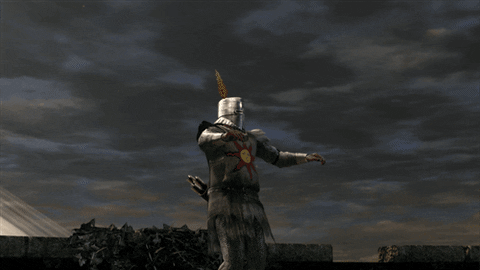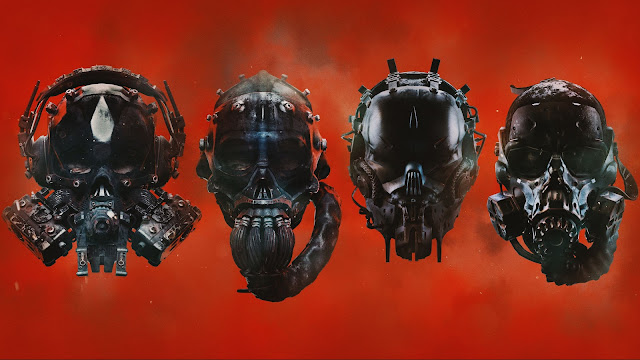Thoughts, musings, ideas and occasionally short rants on the past, present and future of electronics entertainment
Friday, January 28, 2022
Sunday, January 23, 2022
Visual Dissonance
GTFO is a four-player co-op FPS. It's also extremely difficult. The tagline for the game is "work together or die together," but based on personal experience working as a team can still end in disaster. There are, of course, ways to limit the risk. Creating choke points, going stealthy, or simply avoiding places inconsequential to the mission are some methods that can be employed. However, this particular blogpost isn't about all that. Instead, I want to indulge in a bit of introspection by comparing GTFO to another title. It's a little game about danger, darkness and dwarves...
Deep Rock Galactic has an uncanny number of similarities to GTFO. Like that game, it is a four-player co-op FPS. Also like GTFO, each mission consists of delving into a procedurally-generated subterranean maze of poorly illuminated tunnels and chambers with the express goal of completing a specific objective. If I had to point out a big difference between the two, it would be the visuals. GTFO is a very gloomy looking game. Player characters have realistic physical proportions (not to mention psychological tolerances), and the general feel is akin to a wide-awake nightmare. Conversely, Deep Rock Galactic is far more colorful with player characters of somewhat cartoonish proportions (understandably so considering they are supposed to be everyone's favorite bearded race of beer guzzling little people). Overall, the look is World of Warcraft in space. Whereas GTFO takes its cryptic storytelling very seriously, Deep Rock Galactic has a lot of comical cynicism, as well as bits of levity sprinkled into what would otherwise be a very grim situation to find oneself in.
Taking all this into account, along with the fact that GTFO is still in early access, Deep Rock Galactic seems like the obvious choice for people interested in playing a game of this particular subgenre...and yet, I find myself leaning toward GTFO. I was entrenched by similar circumstances concerning Halo and Killzone many years ago. With regards to the quality of moment-to-moment gameplay, Halo is the superior franchise. That said, I spent far more time in those days playing Killzone. Compared to the dreary battlefields of that game, Halo is a riot of color. Like Killzone, Halo has a fairly grim narrative and it's here that I think I have found the reason for my odd tastes in video games. For me, the mood of the story needs be reflected in the visuals. In games like Deep Rock Galactic or the Halo series, I get hit by a form of tonal whiplash...and not in a good way.
I should end this by stressing that I have no prejudice toward bright and colorful games. Two of my favorite games on the PS3 were Flower and the original Valkyria Chronicles. More recently, I played Subnautica on the PS4 and enjoyed that game's aesthetic quite a bit too. It's important to note though the prominent themes in those games are hope, nostalgia and mystery...but not the constant feeling of impending doom. If you happen to be a game designer and are reading this my suggestion would be make sure your artists are on the same page as your story writers, if for no other reason than consistency's sake.
Saturday, January 15, 2022
Dread the Metroid
A combination of two NES titles, Metroid and Castlevania, this particular type of game typically includes a gameplay loop involving exploration and acquisition of new abilities. There are countless examples; Ori, Axiom Verge and Hollow Knight are some of the more prominent titles to come out in recent years. Now that the venerable Samus Aran (protagonist of the Metroid series) has made her debut on the Nintendo Switch, what does this new entry in the long running franchise have to offer? In a word - Dread.
Not dread in that the game is full of bugs or poor design choices...rather the feeling of apprehension one gets when they know the next part of a game will be difficult. I experienced this feeling a lot when playing Dark Souls or Resident Evil and Metroid: Dread has that same vibe sprinkled into it. The feeling is especially prominent whenever one of those E.M.M.I. robots show up. Some of the bosses also evoke the same feeling, though I found that it often gave way to frustration. Much like Donkey Kong Country: Tropical Freeze the developers over at Nintendo Studios are perhaps a bit overzealous about limiting when the player can strike back against a boss monster's relentless onslaught. Regardless, Metroid: Dread is true to its roots even though it never quite achieves the greatness of Super Metroid.
That might sound a bit harsh, but Super Metroid really does stand head-and-shoulders above every other entry in the franchise. The reason is simple, it lets the tension build in ways that no other Metroid game seems to have the patience for. Not just the prologue and intro, but the ghost ship, the boss statue, and the lead-up to the final showdown are all times when the game lets feelings of mystery and apprehension pile on top of each other. The music score adds quite a bit to this, and is (hands down) is some of the best video game music composed by Nintendo. Sadly, Metroid: Dread doesn't emphasize these design elements. Even so, it's still nowhere nearly as bad as Other M in terms of quality. Then again, I'm very bias toward 2-D Metroid games. So, whatever Nintendo has planned next for Samus, I hope it's more like Dread and less like Prime.
Sunday, January 9, 2022
Zero Friction
Generally speaking, F-Zero's attention to detail is what makes it standout to me. Captain Falcon throwing his weigh around inside the glass cockpit of his Blue Hawk when making turns is one example. Another is using the "L" and "R" buttons on the SNES controller to do a power slide resulting in the underside of the vehicle scraping the ground and sending up sparks. The engines have a jet turbine whistle to them that even creates a doppler effect when passing up another racer. According to the in-game speedometer, it's also possible to break the sound barrier. Sadly, there isn't a sonic boom noise, though the explosion sound that occurs when the player wrecks practically qualifies in terms of loudness. The music is top-notch too, with the theme for Mute City being one of my favorites.
In terms of gameplay, it's easy to see the DNA for Mario Kart. There are four vehicles to choose from: the aforementioned Blue Hawk (a jack-of-all-trades), the Golden Fox (a fast accelerator), the Wild Goose (a damage sponge), and Red Stingray (the best of the four owing to it having the highest top speed). The categories that these machines occupy are the protogenesis of Super Mario Kart's racers. Yoshi and Princess Peach being in the same league as the Golden Fox while Bowser and Donkey Kong are derived from the Red Stingray. Obviously, Mario and Luigi are modeled off the Blue Hawk. Only the Wild Goose lacks an equivalent due to life bars not existing in Mario Kart outside of a slight performance boost based on the number of coins held. Also unlike Mario Kart is the absence of any items aside from a mushroom-equivalent speed booster that is awarded after each completed lap. "Energy" (basically health) is lost whenever the player collides with another racer, a landmine, or a wall. Additionally, specially marked patches on both edges of the course (and sometimes scattered across it) cause damage if the player races over them. It's also possible to recover a small amount of energy each lap by steering into a pit zone of sorts. Other than that, there are boost and jump pads, as well as rough patches of ground that reduce speed. After the first lap, generic (unranked) racing vehicles will spawn ahead of the player. They are annoying to deal with, but do help break up the monotony that comes with completing the five laps needed to finish each race.F-Zero got a sequel on the N64, plus a bunch of adaptations to various handheld systems. Regrettably, there hasn't been a new entry in the franchise in over 16 years. Aside from the occasional cameo in other first-party Nintendo titles, it doesn't look like F-Zero is getting much attention from developers. In some ways it makes sense, why make more F-Zero when Mario Kart has all those bases covered and more? Honestly, I think the best way forward for the series would be an overhaul of the mechanics; reimagine F-Zero as an expansive cross-country racer (more rally car than F1) with an emphasis on vehicle upgrades and navigating the topography of alien landscapes complete with hazards and shortcuts. In that way F-Zero could be true to its roots as an pioneering leader, rather than following the pack.











